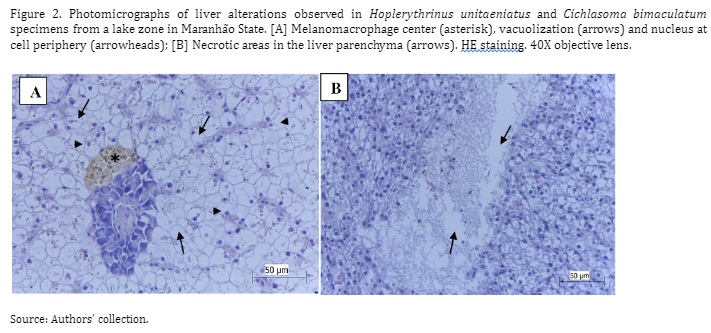Using gill and liver biomarkers to monitor the health of two neotropical fish species in a lake zone in maranhão state
DOI:
https://doi.org/10.21708/avb.2023.17.2.11537Abstract
The aim of the current study is to histologically assess two Neotropical fish species (Hoplerythrinus unitaeniatus and Cichlasoma bimaculatum) to monitor the health of a lake zone in Maranhão State. Forty-two (42) adult fish specimens - 21 belonged to species H. unitaeniatus and 21 to species C. Bimaculatum - were captured, euthanized and had their second right gill arch and liver fragments removed for histological analysis. Histological changes in specimens’ gill and liver were semi-quantitatively assessed by calculating the histological alterations index (HAI) based on the severity of each lesion established as stages I, II and III. Results recorded for both species were presented together; they evidenced that both assessed organs have shown changes associated with all three severity stages. Gill changes mostly observed through the analysis comprised total (85.71%) and partial (85.71%) fusion of several lamellae, epithelial lifting (80.95%), congested blood vessels (76.19%), disorganized lamellae, (76.19%) and lamellar epithelial hyperplasia (76.19%) - stage I alterations. The most common liver changes comprised vacuolization (90.48%), melanomacrophage centers (78.57%), cellular contour deformation (66.67%) and nucleus at cell periphery (52.38%), stage I alterations and hyperemia (45.24%) and cytoplasmic degeneration (40.48%) - stage II. Unlike the HAI indices recorded for gills, liver HAI values presented better distributed rates among severity classifications; therefore, it has evidenced a more severe condition. Thus, both organs analyzed in the investigated species have shown several histological changes that may have resulted from specimens interactions with stressors capable of affecting their health.
Downloads

Downloads
Pubblicato
Fascicolo
Sezione
Licenza
Copyright (c) 2023 Acta Veterinaria Brasilica

TQuesto lavoro è fornito con la licenza Creative Commons Attribuzione 4.0 Internazionale.
Autores que publicam na Acta Veterinaria Brasilica concordam com os seguintes termos: a) Autores mantém os direitos autorais e concedem à revista o direito de primeira publicação, com o trabalho simultaneamente licenciado sob a Licença Creative Commons Attribution que permite o compartilhamento do trabalho com reconhecimento da autoria e publicação inicial nesta revista. b) Autores têm autorização para assumir contratos adicionais separadamente, para distribuição não-exclusiva da versão do trabalho publicada nesta revista (ex.: publicar em repositório institucional ou como capítulo de livro), com reconhecimento de autoria e publicação inicial nesta revista. c) Autores têm permissão e são estimulados a publicar e distribuir seu trabalho online (ex.: em repositórios institucionais ou na sua página pessoal) a qualquer ponto antes ou durante o processo editorial, já que isso pode gerar alterações produtivas, bem como aumentar o impacto e a citação do trabalho publicado (Veja O Efeito do Acesso Livre).


 Esta obra está licenciada com uma Licença
Esta obra está licenciada com uma Licença 